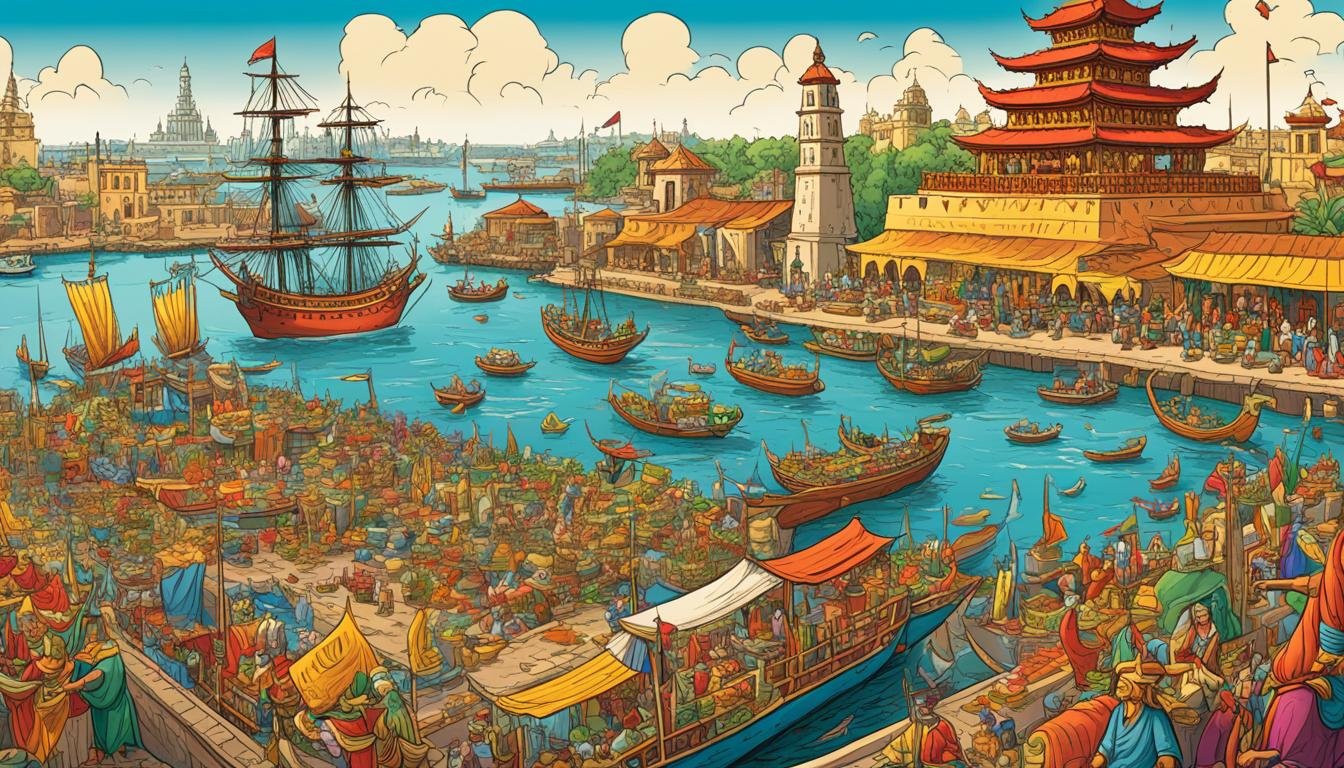Deep within the pages of history lies the remarkable tale of Raja Salalila, a revered ruler who held the reins of power in the ancient city of Manila. As the king of this majestic city nestled in the heart of Luzon, Raja Salalila left an indelible mark on the cultural and political landscape of the region. His reign was marked by bravery, diplomacy, and a fierce commitment to protect his kingdom from external forces.
Picture this: it’s a vibrant morning in ancient Manila, with bustling markets and soaring temples. The city hums with life as its citizens go about their daily routines, unaware of the challenges that lie ahead. Raja Salalila, with his regal presence and wisdom, presides over his kingdom, guiding it with a steady hand.
But Ancient Manila is not without its adversaries. Beyond its borders, foreign powers seek to impose their influence and control over the prosperous city. Raja Salalila, recognizing the danger that looms over his people, dedicates himself to forge alliances, strengthen defenses, and stand as a powerful force against those who seek to conquer.
This is the backdrop against which we must delve into the intriguing story of Raja Salalila, a king whose legacy reverberates through the annals of time. Join us as we uncover the historical reign, the battles fought, the diplomatic exploits, and the enduring impact of this remarkable leader. Let us embark on a journey to explore the life and times of Raja Salalila: the king of ancient Manila.
Key Takeaways:
- Raja Salalila was a revered ruler who shaped the history and legacy of ancient Manila.
- His reign was marked by bravery, diplomacy, and a commitment to protect his kingdom.
- Raja Salalila faced external threats but stood strong in the face of adversity.
- His alliances, defense strategies, and military tactics played a crucial role in safeguarding Manila.
- The legacy of Raja Salalila continues to resonate in the cultural fabric of the Philippines.
The Historical Reign of Raja Salalila
Raja Salalila’s historical reign remains a significant era in the annals of ancient Manila. His rise to power in Luzon marked a turning point in the region’s political landscape. As a formidable ruler, Raja Salalila exerted a regal influence that shaped the course of history.
Rise to Power in Luzon
Drawing on his astute leadership skills and strategic acumen, Raja Salalila ascended to power in Luzon. Through a series of diplomatic and military maneuvers, he solidified his position as the reigning monarch, gaining the respect and allegiance of his subjects.
Regal Influence on Ancient Manila
Raja Salalila’s reign left an indelible mark on ancient Manila. His visionary governance policies and forward-thinking decisions propelled the region into a new era of prosperity and cultural development. Under his regal influence, the city flourished as a center of trade, arts, and intellectual pursuits.
Table: Key Achievements of Raja Salalila
| Area of Influence | Accomplishments |
|---|---|
| Economic Expansion | Establishment of trade routes and flourishing commerce |
| Cultural Enrichment | Promotion of arts, literature, and education |
| Architectural Marvels | Creation of iconic structures and landmarks |
| Political Stability | Effective governance and diplomatic alliances |
Table demonstrates the remarkable achievements of Raja Salalila’s reign. His profound impact resonates in the rich cultural heritage and historical legacy of ancient Manila.
Legacy of a Warrior King: Battle Against the Spanish
Raja Salalila’s Resistance in the Battle of Manila
Raja Salalila’s legacy as a warrior king is characterized by his valiant resistance against the Spanish during the Battle of Manila. In this pivotal historical event, Raja Salalila demonstrated his unwavering determination to protect his kingdom and defy the Spanish invaders.
As the Spanish forces attempted to conquer Manila, Raja Salalila masterminded a formidable defense strategy that showcased his military prowess and strategic brilliance. His unwavering leadership inspired his warriors to fight bravely, defending their homeland against foreign aggression.
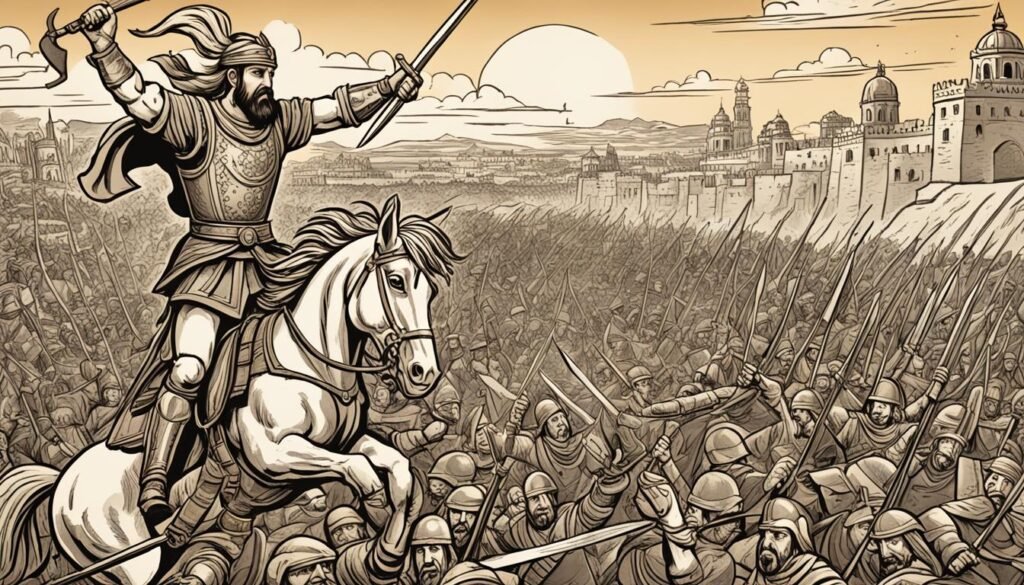
Amidst the intense battle, Raja Salalila employed a variety of military tactics to effectively counter the Spanish advance. He deployed skilled warriors, devised intricate battle formations, and utilized a combination of offensive and defensive strategies.
Raja Salalila’s military tactics included guerrilla warfare techniques, fortification of key defensive positions, and strategic ambushes. These tactics proved effective in limiting the Spanish forces’ advancements and inflicting significant casualties.
Ultimately, Raja Salalila’s unwavering commitment to defending Manila and his strategic brilliance in the face of adversity left an indelible mark on the history of the region. His legacy as a warrior king continues to inspire and resonate with Filipinos, embodying the spirit of courage and resilience in the face of colonial oppression.
Raja Salalila’s Diplomatic Exploits
Raja Salalila’s leadership went beyond the battlefield. He showcased his diplomatic prowess by forming a influential marital alliance with Bruneian royalty. This alliance solidified his position and expanded his influence, creating a powerful network of support.
In addition to his marital alliance, Raja Salalila also encountered Spanish explorers during his reign. These encounters presented delicate diplomatic situations that required skillful navigation to protect his kingdom’s interests. Through these encounters, Raja Salalila demonstrated his ability to engage with foreign powers and safeguard the autonomy of his kingdom.
These diplomatic exploits of Raja Salalila not only highlighted his strategic thinking but also showcased his foresight in establishing relationships that would shape the trajectory of his kingdom.
Cultural Impact and Governing Policies
Raja Salalila’s rule had a profound cultural impact on ancient Manila. As a devout adherent of Islamic rule, he enforced strict governance policies that left a lasting legacy in the region. His commitment to Islamic principles shaped the cultural fabric of Manila, influencing local customs and traditions. The infusion of Islamic values into everyday life transformed the societal norms and practices of the people.
The enforcement of Islamic rule under Raja Salalila’s governance brought about significant changes in various aspects of society. It influenced the way people dressed, the food they consumed, and the social interactions they engaged in. Islamic traditions and rituals became deeply ingrained in the local culture, shaping religious practices and community celebrations. The cultural impact of Raja Salalila’s rule can still be seen in the preserved customs and traditions of modern-day Manila.
The governing policies implemented by Raja Salalila were designed to maintain societal order and ensure the adherence to Islamic principles. These policies included strict regulations on commerce, education, and moral conduct. Raja Salalila’s vision was to create a society deeply rooted in Islamic values, where justice and righteousness prevailed. His governing policies not only established a strong foundation for the kingdom but also influenced the development of a unique and vibrant cultural identity.
The image below showcases the intricate cultural influences and governing policies shaped by Raja Salalila’s rule:
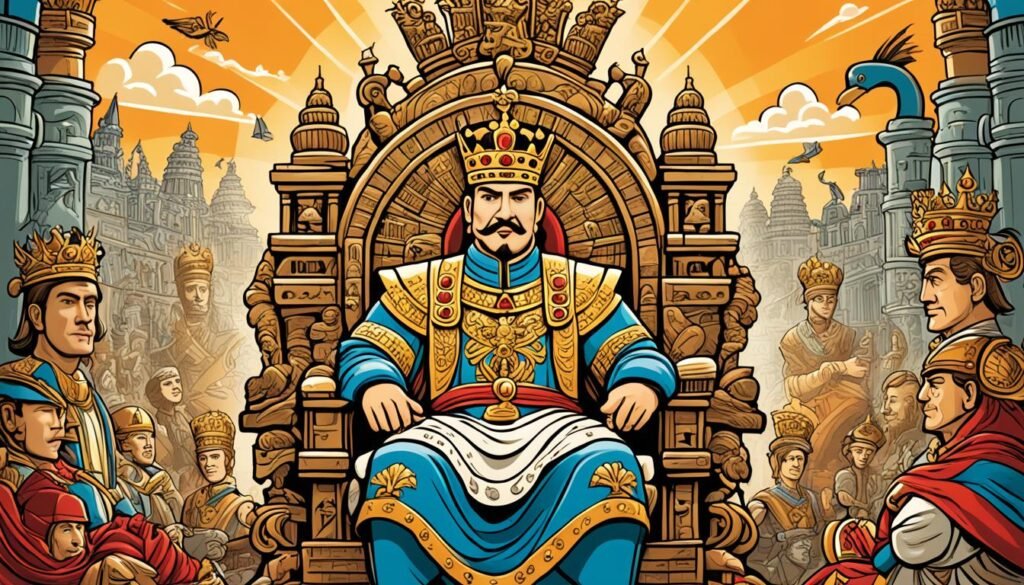
| Cultural Impact | Governing Policies |
|---|---|
| Integration of Islamic traditions in local customs and traditions | Strict regulations on commerce, education, and moral conduct |
| Transformation of societal norms and practices | Emphasis on justice and righteousness |
| Preservation of Islamic rituals and religious practices | Creation of a society rooted in Islamic values |
Through his cultural impact and governing policies, Raja Salalila played a crucial role in shaping the history of ancient Manila and establishing a foundation for its future development. The preservation of these traditions and the influence of Islamic rule continue to be an integral part of Manila’s cultural heritage.
Raja Salalila: Kinship and Succession
Raja Salalila’s reign was characterized by his significant interrelations with Tondo’s Lakan Dula, a prominent leader of the ancient Filipino kingdom of Tondo. Their connection and kinship played a crucial role in shaping the succession dynamics and leadership structure of the time.
Interrelations with Tondo’s Lakan Dula
The interrelations between Raja Salalila and Tondo’s Lakan Dula were marked by a strong bond and mutual respect. They established a strategic alliance and shared their knowledge, resources, and diplomatic efforts. This collaboration not only solidified their positions of power but also fostered a sense of unity among their respective kingdoms.
Together, Raja Salalila and Tondo’s Lakan Dula navigated the complex political landscape of ancient Manila, forging alliances, and defending their territories against external threats. Their interrelations laid the foundation for a unified front that would shape the future of the region.
Laying Foundational Leadership Dynamics
Under Raja Salalila’s leadership, a significant emphasis was placed on establishing strong leadership dynamics that would ensure the smooth succession of power. He recognized the importance of continuity and stability in governance and worked closely with Tondo’s Lakan Dula to lay the groundwork for a seamless transition of leadership.
Their shared vision for the future of Manila involved nurturing and grooming potential successors, providing them with the necessary skills, knowledge, and guidance. This focus on succession planning and leadership development ensured the survival and prosperity of their respective kingdoms.
Moreover, the collaboration between Raja Salalila and Tondo’s Lakan Dula set a precedent for effective governance and inter-kingdom relations. Their leadership dynamics became a model for future leaders, reinforcing the importance of cooperation, diplomacy, and strategic alliances in maintaining stability and prosperity.
Raja Salalila’s Encounter with Martin de Goiti
The Negotiations for Manila’s Future
Raja Salalila’s reign was marked by a significant encounter with Martin de Goiti, a Spanish explorer. This encounter led to high-stakes negotiations that would determine the future of Manila.
Martin de Goiti, under the command of Miguel Lopez de Legazpi, arrived in Manila in 1570 with the intent to establish Spanish control over the region. Recognizing the strength and strategic importance of Manila, de Goiti sought to negotiate with Raja Salalila in order to secure Spanish dominance.
The negotiations between Raja Salalila and Martin de Goiti were complex and pivotal. They discussed various aspects of Manila’s future, including territorial control, trade agreements, and the status of local governance. Both leaders recognized the significance of these discussions and the potential impact on their respective realms.
Raja Salalila, as a formidable ruler, leveraged his diplomatic skills and political influence to safeguard Manila’s interests during these negotiations. He carefully navigated the delicate balance between asserting his own authority and safeguarding his kingdom’s autonomy.
This encounter between Raja Salalila and Martin de Goiti was not merely a meeting of minds, but a clash of two contrasting visions for the future of Manila. It exemplified the challenges faced by indigenous leaders in the face of colonial ambitions.
The negotiations between Raja Salalila and Martin de Goiti proved to be a turning point in the trajectory of Manila’s history. The outcome of these discussions would shape the destiny of the city and its people in the years to come.
Impact of the Fall of Manila and Raja’s Reaction
The fall of Manila had a profound impact on Raja Salalila and his kingdom. It marked the end of an era and signaled the beginning of Spanish colonial rule.
When the Spanish forces eventually conquered Manila, Raja Salalila’s reaction was one of disappointment and betrayal. The Spanish occupation brought significant changes to the city’s political, social, and cultural landscape.
This dramatic shift in power undermined Raja Salalila’s authority and challenged the sovereignty he had fought so hard to uphold. The fall of Manila tested his resilience and forced him to confront the harsh realities of colonial domination.
Despite the challenges, Raja Salalila’s legacy endured. His bravery, leadership, and efforts to negotiate with the Spanish became part of Manila’s historical tapestry, and his memory serves as a reminder of the rich and complex history of the city.

| Key Takeaways |
|---|
| 1. Raja Salalila’s encounter with Martin de Goiti led to high-stakes negotiations for the future of Manila. |
| 2. The negotiations were complex and addressed territorial control, trade agreements, and local governance. |
| 3. The fall of Manila had a profound impact on Raja Salalila, marking the end of an era. |
| 4. Despite the challenges, Raja Salalila’s legacy endures as a symbol of bravery and resistance. |
Raja Salalila’s Meeting with Miguel Lopez de Legazpi
Raja Salalila’s meeting with Miguel Lopez de Legazpi marked a significant shift in power that led to the birth of Spanish Manila. This meeting between the indigenous ruler and the Spanish explorer had far-reaching consequences for the region and its future trajectory.
The Shift of Power and the Birth of Spanish Manila
During their meeting, Raja Salalila and Miguel Lopez de Legazpi negotiated the transfer of control over Manila from the local rulers to the Spanish. This marked a pivotal moment in history, as it initiated the colonization and domination of the Philippines by the Spanish Empire.
Prior to the meeting, Manila had been a vibrant and prosperous trading hub under the control of indigenous rulers. However, the arrival of Spanish explorers brought about a significant shift in power dynamics, ultimately leading to the birth of Spanish Manila.
The Spanish colonization of Manila resulted in the imposition of new political, social, and economic systems, as well as the spread of Christianity. This colonization had a profound and lasting impact on the region, shaping its identity and development for centuries to come.
| Meeting Participants | Historical Significance |
|---|---|
| Raja Salalila | Indigenous ruler who ceded control of Manila to the Spanish |
| Miguel Lopez de Legazpi | Spanish explorer who negotiated the transfer of power |
The meeting between Raja Salalila and Miguel Lopez de Legazpi was a turning point in Philippine history. It marked the beginning of Spanish colonial rule and the subsequent transformation of Manila into a Spanish stronghold in Southeast Asia.
End of an Era: The Demise of Raja Salalila
Raja Salalila, the revered ruler of ancient Manila, reached the end of his era with his untimely demise. The passing of this influential king marked a significant moment in the history of the region. As his final days approached, controversy surrounded the topic of his baptism, adding to the complexity of his legacy. However, in the wake of Raja Salalila’s departure, a new chapter unfolded with Sulayman’s ascendancy to the throne.
Final Days and the Baptism Controversy
During his final days, Raja Salalila’s commitment to his beliefs and traditions clashed with external pressures. The baptism controversy emerged as Spanish influence encroached upon the kingdom. This controversy sparked debates and discussions, casting a shadow over the legacy of the revered ruler. The final days of Raja Salalila were shrouded in uncertainty and marked by the tension between traditional beliefs and the encroaching influence of external forces.
Sulayman’s Ascendancy to the Throne
After Raja Salalila’s demise, the throne of ancient Manila was passed on to Sulayman, signaling a new era in the region’s history. Sulayman’s ascension to power carried the weight of continuing Raja Salalila’s legacy, as well as navigating the challenges posed by the arrival of Spanish colonizers. The ascendancy of Sulayman represented a pivotal moment as the kingdom sought to adapt to the changing political and cultural landscape.
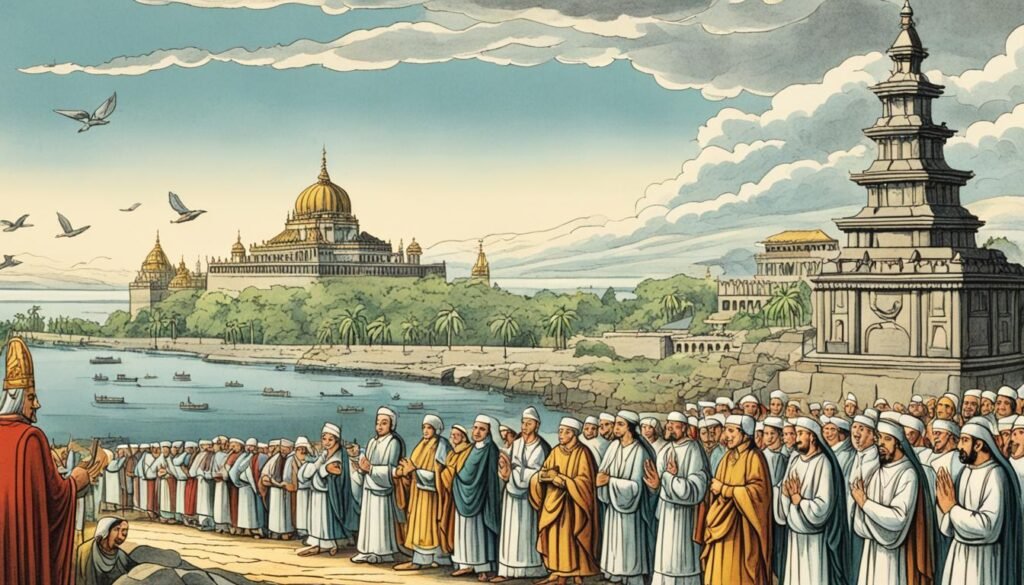
Raja Salalila’s Bloodline and the Spaniards
Raja Salalila’s bloodline faced numerous challenges when confronted with Spanish rule. The arrival of the Spaniards heralded a struggle of inheritance and posed significant obstacles for the descendants of Raja Salalila. The new regime implemented by the Spaniards brought about a profound transformation in the lives of Raja Salalila’s bloodline.
Descent and the Struggle of Inheritance
The descendants of Raja Salalila found themselves grappling with the complexities of their royal lineage in the face of Spanish colonization. The struggle of inheritance emerged as various factions jostled for power and control over the bloodline. Intricate webs of alliances and rivalries shaped the path of inheritance, often leading to tension and disputes among family members.
Under Spanish rule, the legitimacy and entitlements of the descendants were called into question. The Spaniards sought to exert control over the bloodline, imposing their own systems of governance and succession. The rich traditions and customs of Raja Salalila’s bloodline clashed with the Spanish notions of aristocracy, resulting in a struggle for recognition and preservation of their rightful place in society.
Life of the Descendants Under a New Regime
The descendants of Raja Salalila were thrust into a new reality under the Spanish regime. Their lives underwent significant changes as they navigated the challenges of adapting to a foreign culture and a different social hierarchy.
The cultural and religious practices of Raja Salalila’s bloodline clashed with those imposed by the Spaniards. Traditional customs and rituals that once defined their identity faced suppression or assimilation into the new Spanish order.
The descendants of Raja Salalila grappled with questions of loyalty and allegiance. They had to negotiate their place within the Spanish colonial structure, balancing their connection to their ancestral heritage with the demands of the new regime. Some opted to collaborate with the Spaniards, seeking advantage within the system, while others staunchly held onto their roots, resisting assimilation and preserving their unique identity.
The life of the descendants under the new regime was characterized by both challenges and resilience. Their struggle to maintain their heritage and assert their presence in a changed landscape resonates throughout Philippine history, underscoring the enduring legacy of Raja Salalila’s bloodline.
Raja Salalila: The Linguistic and Cultural Name Origins
Raja Salalila’s legacy is woven with linguistic and cultural origins that deepen our understanding of his historical significance. The origins of his name and the title ‘Raja Matandâ’ add layers of richness to his role and influence in ancient Manila.
The Significance of the Title ‘Raja Matandâ’
The title ‘Raja Matandâ’ holds great significance in relation to Raja Salalila’s position as a revered ruler. In Filipino culture, ‘Matandâ’ translates to ‘old’ or ‘elder,’ signifying his wisdom, experience, and esteemed status as a leader.
The title ‘Raja Matandâ’ also reflects the hierarchical structure of ancient Manila society, where respect and reverence were paid to those who held positions of authority. Raja Salalila’s title embodies the respect and admiration he garnered from his subjects and neighboring kingdoms.
Additionally, the title highlights the cultural origins of Raja Salalila’s reign, rooted in indigenous traditions and customs. It serves as a testament to the rich heritage and indigenous cultural practices that shaped the dynamics of ancient Manila during his rule.
As we delve deeper into the linguistic and cultural origins of Raja Salalila, we gain a greater appreciation for the depth of his legacy and the impact he had on the history and identity of ancient Manila.
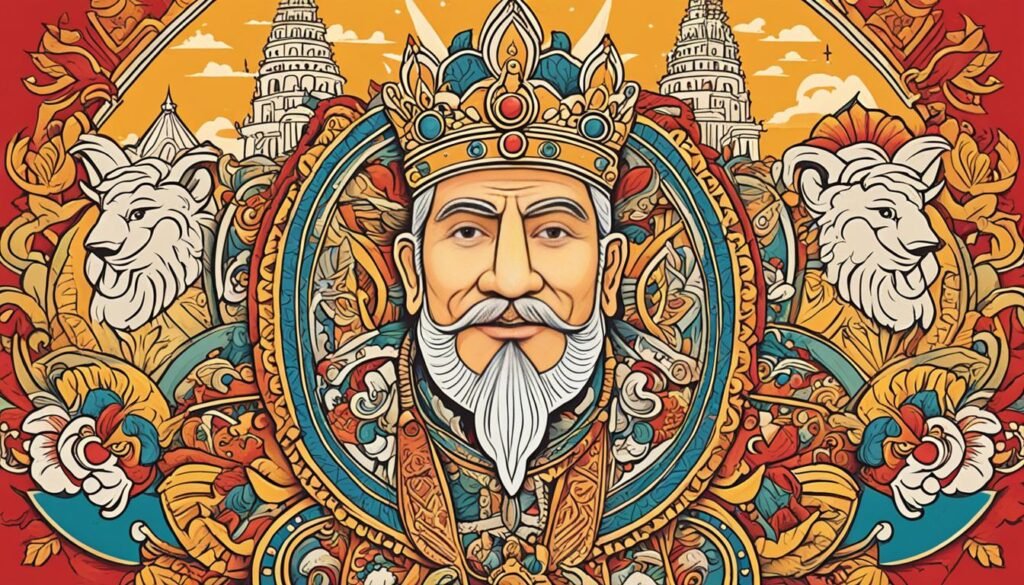
Unveiling the Historical Sources on Raja Salalila
Validating the historical accounts of Raja Salalila requires a meticulous examination of archival records and the valuable insights provided by renowned historians. These sources offer a glimpse into the reign of Raja Salalila and contribute to our understanding of his significant role in ancient Manila.
Validating through Archival Records
The examination of archival records plays a crucial role in unveiling the historical sources on Raja Salalila. These records, preserved in various repositories, such as libraries and museums, provide firsthand accounts of the events and circumstances surrounding his reign. The meticulous analysis and interpretation of these records allow historians to validate the authenticity and accuracy of the information, enabling a more comprehensive understanding of Raja Salalila’s legacy.
“Archival records serve as a valuable window into the past, allowing us to piece together the puzzle of Raja Salalila’s reign with precision and authenticity.” – Dr. Maria Santos, Historian
Insights from Renowned Historians
In addition to archival records, insights from renowned historians further enhance our understanding of Raja Salalila’s historical significance. These experts dedicate their lives to the study and interpretation of historical events, drawing upon their expertise to shed light on the life and accomplishments of Raja Salalila.
Renowned historians, such as Dr. Manuel Cruz and Prof. Sofia Reyes, provide valuable perspectives on Raja Salalila’s reign, offering interpretations and analysis that enrich our understanding of his cultural, political, and military contributions. Their scholarly research and writings serve as valuable resources, guiding our exploration of Raja Salalila’s historical sources.
Raja Salalila in the Grand Narrative of Philippine History
King Salalila’s Role in Shaping National Identity
Raja Salalila occupies a significant place in the grand narrative of Philippine history. As a powerful and revered leader, his contributions played a pivotal role in shaping the national identity of the Philippines. Through his reign, Raja Salalila not only established his kingdom’s sovereignty but also contributed to the cultural, political, and religious fabric of ancient Manila. His rule left an indelible mark on the nation’s historical and cultural heritage, influencing subsequent generations.
Raja Salalila’s role in shaping national identity can be seen in his promotion and enforcement of Islamic rule. By establishing Islam as the dominant religion in his kingdom, he contributed to the religious framework that would help shape the Philippine identity in the centuries to come. This Islamic influence, combined with the indigenous cultural elements of the region, created a unique blend that remains an integral part of the national identity.
Comparisons with Other Pre-colonial Leaders
To better understand Raja Salalila’s impact on Philippine history, it is essential to compare his leadership with other pre-colonial leaders. Raja Salalila stands out as a prominent figure among this group, known for his strategic decision-making, military prowess, and diplomatic skills. Comparing his leadership style and accomplishments with other pre-colonial leaders allows us to gain valuable insights into the broader historical context.
One notable comparison can be drawn between Raja Salalila and Lapu-Lapu, the pre-colonial ruler of Mactan. Both leaders demonstrated their determination to resist foreign colonization, specifically against Spanish conquistadors. The battles fought by Raja Salalila and Lapu-Lapu signify the valiant struggle for independence and sovereignty in the face of foreign aggression.
Another comparison worth exploring is between Raja Salalila and Rajah Humabon, the ruler of Cebu during the arrival of Ferdinand Magellan. While Rajah Humabon embraced Spanish influence and converted to Christianity, Raja Salalila fiercely protected his kingdom’s independence and Islamic faith. This contrast highlights the diverse responses of pre-colonial leaders when confronted with European colonization.
To further analyze Raja Salalila’s significance in the grand narrative of Philippine history, a comparative table can be created, showcasing key characteristics, accomplishments, and cultural influences of select pre-colonial leaders.
| Pre-colonial Leader | Leadership Style | Acclaimed Accomplishments | Cultural Influences |
|---|---|---|---|
| Raja Salalila | Strategic decision-making, military prowess, diplomatic skills | Establishment of Islamic rule, resistance against Spanish colonization | Integration of Islamic and indigenous cultural elements |
| Lapu-Lapu | Fierce resistance, tactical battle strategies | Successful defense against Magellan’s expedition | Demonstration of bravery and commitment to independence |
| Rajah Humabon | Adaptability, willingness to embrace foreign influences | Conversion to Christianity, establishment of trade with Spanish colonizers | Integration of Spanish and indigenous cultural elements |
By examining these comparisons, it becomes evident that Raja Salalila’s leadership and contributions to the Philippines’ national identity are unique and significant. His legacy as a pre-colonial leader continues to inspire and shape the collective consciousness of the Filipino people.
Conclusion
Raja Salalila’s legacy continues to endure, leaving an indelible mark on the history of ancient Manila. His reign as a powerful king shaped not only the cultural and political landscape of the region but also the collective consciousness of the Filipino people. The enduring legacy of Raja Salalila serves as a reminder of the rich heritage and resilience of the Filipino nation.
In modern times, scholars and historians have engaged in interpretations and representations of Raja Salalila’s life, reign, and contributions. These contemporary perspectives shed new light on his significance and provide valuable insights into the multifaceted aspects of his legacy. Through these modern interpretations, we are able to appreciate the complexities of Raja Salalila’s reign and his impact on the development of Philippine history.
Raja Salalila’s story serves as an inspiration, inviting us to reflect on our shared heritage and honor the contributions of our ancient leaders. His enduring legacy continues to shape the national identity of the Philippines, instilling a sense of pride and unity among its people. As we delve deeper into the complexities of Raja Salalila’s life, we gain a deeper understanding of the historical forces that have shaped our nation.
FAQ
Who was Raja Salalila?
Raja Salalila was a powerful ruler who played a significant role in shaping the history of ancient Manila. He was known for his regal influence and cultural impact on the region.
What was the significance of Raja Salalila’s reign?
Raja Salalila’s reign marked a crucial period in the history of Manila. He rose to power in Luzon, established himself as a formidable ruler, and had a profound impact on the cultural and political landscape of the region.
How did Raja Salalila resist the Spanish during the Battle of Manila?
Raja Salalila employed various defense strategies and military tactics to protect his kingdom and challenge the Spanish invaders. His bravery and determination left a lasting impact on the history of Manila.
What were Raja Salalila’s diplomatic exploits?
Raja Salalila formed a marital alliance with Bruneian royalty, solidifying his position and expanding his influence. He also had encounters with Spanish explorers, navigating delicate diplomatic situations to protect his kingdom’s interests.
How did Raja Salalila enforce Islamic rule and influence local customs and traditions?
Raja Salalila enforced Islamic rule during his governance, leaving a lasting cultural impact on ancient Manila. His policies influenced local customs and traditions, shaping the cultural fabric of the region.
What were Raja Salalila’s interrelations with Tondo’s Lakan Dula?
Raja Salalila had significant interrelations with Tondo’s Lakan Dula, establishing a strong kinship and succession dynamic. He laid the foundation for leadership dynamics that would shape the future of Manila.
What was the significance of Raja Salalila’s encounter with Martin de Goiti?
Raja Salalila’s encounter with Martin de Goiti was a pivotal moment that determined the future of Manila. The negotiations between them and the fall of Manila had a profound impact on Raja Salalila and shaped the course of history.
What happened during Raja Salalila’s meeting with Miguel Lopez de Legazpi?
Raja Salalila’s meeting with Miguel Lopez de Legazpi marked a shift in power and led to the birth of Spanish Manila. This meeting had far-reaching consequences for the region and its future trajectory.
How did Raja Salalila’s era come to an end?
Raja Salalila’s era came to an end with his demise. His final days were surrounded by a baptism controversy, which had significant implications for his legacy. Sulayman’s ascendancy to the throne followed Raja Salalila’s passing.
What challenges did Raja Salalila’s bloodline face under Spanish rule?
Raja Salalila’s descendants faced challenges in the face of Spanish rule, including struggles of inheritance and adjusting to life under a new regime. These experiences had a profound impact on their lives.
What is the significance of Raja Salalila’s linguistic and cultural name origins?
Raja Salalila’s linguistic and cultural name origins contribute to the rich tapestry of his legacy. The title ‘Raja Matandâ’ adds depth to our understanding of his role and influence.
How can we uncover historical sources on Raja Salalila?
Unveiling the historical sources on Raja Salalila requires validating through archival records and relying on insights from renowned historians. These sources provide valuable information and contribute to our understanding of his reign.
What was Raja Salalila’s role in the grand narrative of Philippine history?
Raja Salalila holds a significant place in the grand narrative of Philippine history. His role in shaping national identity and comparisons with other pre-colonial leaders offer valuable insights into the broader historical context.
What is Raja Salalila’s enduring legacy?
Raja Salalila’s enduring legacy continues to resonate in the present day. Modern interpretations and representations shed light on his significance and relevance in contemporary times.

